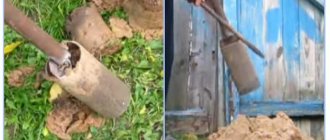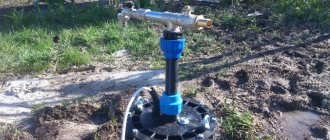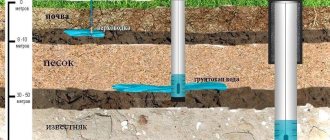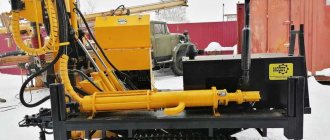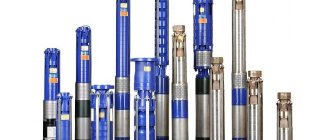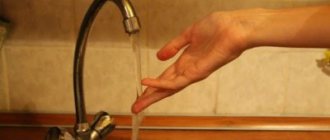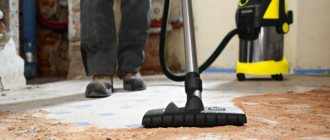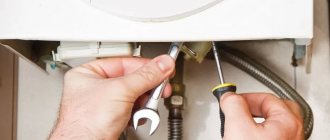Connecting to a centralized water supply is sometimes impossible, and often simply unprofitable. An excellent alternative to it in a private home is a well that meets the water needs for everyday needs. Such a fluid source requires regular maintenance and well cleaning is an important procedure that must be carried out annually. Read the article to the end and you will learn which cleaning method to choose for your area, as well as ways to reduce pollution.
Well flushing Source strojdvor.ru
The main reasons for clogged water wells
The reasons for the appearance of contaminants can be different: from improper installation of downhole equipment to a banal fall of contaminants from the surface. There are only two types of pollution: sanding and silting. And before starting work, it is important to understand where the pollution comes from, because the identified source of pollution is the beginning of the path to choosing the most effective method of cleaning the well
Sanding
A water well designed and constructed in accordance with all the rules helps to avoid unnecessary impurities and sand grains getting into the casing. The opposite state of affairs can be caused by:
- The caisson or cap is not sealed.
- Incorrect filter selection or damage.
- This is often caused by poor-quality welding of elements, breakdowns of a plastic pipe, or severe corrosion of a metal pipe.
Sand in well water Source build-experts.ru
Siltation
The accumulation of small particles on the filter leads to clogging of the filter cells. This complicates the process of water penetration into the mine shaft, and the process of “siltation” begins. There may be a complete loss of water supply. This process itself occurs quite slowly and in a source that is regularly exploited can last for decades.
At the same time, improper well design and the ingress of dirt from the surface can lead to rapid siltation even in a well that is in constant use. In the case when the well is not in operation, this process occurs much faster and only a couple of years can pass before the liquid completely disappears. Timely treatment of the well and removal of silt before the water completely dries up can give the source a second wind.
Well pumping Source yandex.ru
Subtleties of well cleaning
All work that can return clean water suitable for consumption must be carried out in compliance with safety requirements. They often use acids and hazardous operating mechanisms. Cleaning wells of silt and sand is carried out on the basis of three principles of impact on pollution: pumping, washing or blowing. There are quite a lot of well cleaning methods based on one of these principles. They differ not only in financial affordability, but also in the effort and time spent. In addition, the choice of a specific principle depends on the type of pollution. We will tell you about the six most effective ones.
How to clear a well of sand: using a vibration pump
The choice of vibration pump cleaning method is suitable for removing sand from the well. It is not demanding on the quality of the liquid that is passed through it and is capable of passing through even small stones. Of course, an abrasive can damage the check valve, but this structural element costs little and you can change it yourself very quickly.
The vibration pump itself is a cheap tool. Its price is several times lower than a circulation pump, which can be easily damaged by abrasives. And a vibration pump that fails is not such a big blow to the family budget.
Cleaning a well using a vibration pump Source tvplaneta.ru
See also: Catalog of companies that specialize in water supply and sewerage work of any complexity
This method does not allow you to get rid of siltation of the soil, but it makes it possible to raise impressive volumes of sand. In addition, it can be used in water wells with shallow depths (maximum 50 meters). To eliminate contamination, the vibrating device needs to lie at a height of only a couple of centimeters above the bottom level, which will deepen during operation. Therefore, the pump itself will need to be drained.
The vibration pump should not be used for too long and needs a fifteen-minute rest every half hour. The presence of an abrasive with a diameter close to 5 mm can clog the membrane, and to clean it you will need to lift the unit upward. Cleaning water wells using the method described above takes quite a long time and not every time its efficiency is high. However, using a vibration pump requires virtually no manual work.
Flushing a well with a pump from the surface
Removal of pollutant particles from the well can be done by supplying water from above. Then the flushing liquid will be supplied by the pump and push out the contaminants. It will be necessary to consider a drain for contaminants and ensure that they do not fall back into the well.
To avoid swamping the land, it is necessary to flush water wells using a closed cycle. Then you will need containers equal to the volume of the casing.
Container for contaminated liquid Source ad-cd.net
The flushing liquid constantly travels from the water well to the tank and back. In this case, contaminants collecting in the container will have to be removed periodically. A high-power pump is a must-have tool for such flushing. You can enhance the effect of the work if you add orthophosphoric acid to the liquid.
Important to remember! The acid is quenched with soda and if you add it to the flushing liquid, you will need to pump the well for at least 6 hours so that the water from it is suitable for consumption.
Two flushing pumps
Deeper wells are almost impossible to flush with a vibrating pump or water supply. The vibration pump simply does not have enough performance, and the pressure caused by the water supply simply physically will not allow pollution to overcome the water barrier, and a significant part of it will remain at the bottom. How to clean a deep well:
- For such flushing, two pumps are required.
- A surface pump supplies flushing fluid to the bottom of the water well, and a deep pump pumps dirt to the top. Dirt can be removed using a standard pump.
- For such cleaning, you only need to install a hose that supplies liquid from the surface to the bottom of the water well.
Two pump method Source lanaza.ru
Extracting sand with a bailer
The source cleaning technology with a bailer is effective when it is necessary to remove a large amount of pebbles, sand and compressed fine sediments from the casing pipe. But it is practically useless when you need to clean the filter and the surrounding soil.
The bailer consists of a piece of steel pipe 1 - 1.5 meters long, on one side of which there is a valve, and on the other - a lever-eye for the cable. The valve is a heavy steel ball held in place by a washer attached to a thread.
This method is often used when cleaning artesian wells. It is advisable to completely pump out the water from the casing. With a sharp movement the bailer is lowered to the bottom of the source. When it hits the sand, the valve opens and a certain amount of sand penetrates into the device.
Raising the projectile to the surface, the contaminants are shaken out of it. This process is repeated several times. You can work with a bailer manually, but it is a difficult task, even if you work together. To raise and lower the projectile and steel cable, it is better to use a tripod equipped with a winch or pulley.
You can purchase a bailer of a specific diameter from a specialized enterprise, make it yourself, or rent it. When using it, you need to act carefully when approaching the projectile to the filter, since there is a possibility of damaging the fine mesh. It is better to remove the remaining deposits at the very bottom using another method that does not involve impact.
Video description
Water hammer cleaning of a silted well is shown in the video:
Gas-air mixture for well flushing
Now let's talk about how to flush a well using compressed air (bubbling method). The hardest and most expensive thing will be to get a powerful compressor. As for the rest, the algorithm of action is very simple: compressed air is supplied to the bottom by a sprayer located below the bottom level (under a layer of silt and sand). The gas-air mixture will rush upward, lifting dirt with it. To ensure the flow of contaminated water, you need to regularly add flushing liquid manually or using a pump.
With such flushing, it is possible to create a closed system with circulation of the flushing liquid. Even though this method is not productive enough, the process can last for weeks. But if all the above methods do not produce results or they cannot be used due to the risk of damaging the filter, then bubbling is almost the only way to clean the well.
Elimination of pollution by water hammer
The use of water hammer is especially effective if it is necessary to get rid of silt deposits in the filter or the soil adjacent to it. When there is no sand in the casing pipe, and water after prolonged flushing or pumping does not flow into the well in the required volume, this may indicate that the soil is heavily silted.
As a rule, when a mud plug forms, it can be removed with your own hands using water hammer. Before cleaning a well in a country house or local area using this method, you will need to make a simple projectile, which is a heavy pipe, the diameter of which is slightly smaller than that of the casing. It should fit inside her with a small gap.
The end of the projectile is welded tightly, and at the opposite end there are eyes for securing the cable. The well is filled several meters with water, to which it is advisable to add phosphoric acid, which helps get rid of rust particles and calcium deposits.
The projectile is sharply lowered into the liquid, then raised and dropped again. The steps are repeated for several hours, and then the casing is filled to the top with water, after which it is flushed or pumped. If the required result is not achieved, the procedure is repeated. Often you have to do it a dozen times to get rid of calcium or silt deposits.
Which cleaning method to choose
It can be extremely difficult to accurately identify the causes of pollution, and even professionals can make mistakes. When there are grains of sand in well water, this does not exclude the possibility of soil siltation. Therefore, cleaning it from all kinds of contaminants and restoring the supply of clean water suitable for consumption and use in everyday life requires a lot of effort and patience.
Clean water from a well Source neindianaarticles.com
It is best to start with the easiest methods and, if they do not help, move on to the next ones. First try pumping with a vibration pump. If this method does not change anything, proceed to washing. You need to start cleaning the well using the flushing method when the water has almost dried up. Large volumes of sand require the use of a bailer, which is not suitable for cleaning plastic casings. Polymer ones need to be cleaned only by bubbling. And the absence of sand and liquid in the steel casing requires the use of water hammer. Hiring specialized equipment can be expensive, but the efficiency and speed of cleaning will differ significantly from manual methods.
Types of drainage electric pumps
The main purpose of this equipment is pumping out liquid. A pump for pumping water from a well is used in cases where the level of pollution is low. The scope of operation of drainage electric pumps is very extensive. They can be used in the following cases:
- When eliminating the consequences of disasters associated with an increase in water level in the room.
- When pumping groundwater during flood periods.
- When cleaning reservoirs and other reservoirs.
- When eliminating flooding of basements and other premises as a result of significant amounts of precipitation.
- When watering green spaces and arranging fountains.
The currently existing types of drainage devices are divided into two categories:
- superficial;
- submersible
A drainage electric pump of any type for a well shaft or borehole is distinguished by its simple operation, affordable price, the prospect of independent installation and its easy replacement with a new one.
A common and widely used by summer residents and owners of country houses is a type 2 well pump, the types of which are divided into vibration and centrifugal. Each of them, of course, has its own positive and negative sides. However, all of them can be used to restore the normal functioning of the water source.
Briefly about the main thing
Knowing all the ways to clean a well from sand and silt, you can choose the best one for a particular case. The two main reasons causing well contamination are sanding and silting. Cleaning methods such as: flushing the well with a vibration pump, a pump from the surface, two pumps, or cleaning with a bailer will help you cope with the first problem.
The second type of contamination can be removed using the water hammer method.
Using the bubbling method will eliminate both of these contaminants. This method is also used for delicate well cleaning, but it is not a panacea because it requires special equipment and a lot of time.
It is important to remember that such work is extremely difficult, and sometimes simply overwhelming. That carelessness in handling tools and heavy metal implements can seriously damage the water source.
